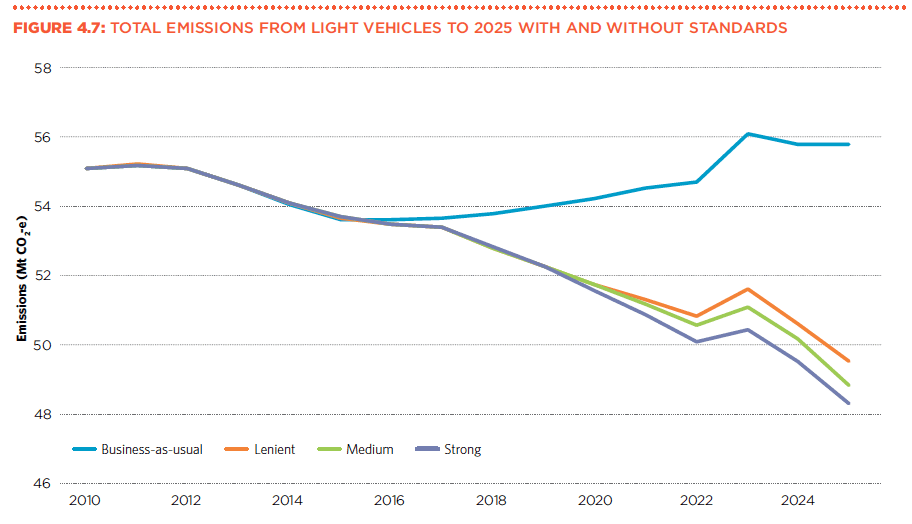Australia’s Climate Change Authority – set to have a reprieve from repeal thanks to Clive Palmer (and Labor and the Greens) has called for Australia to follow international practice and set emission standards for light vehicles.
The CCA proposes a mandatory carbon dioxide emission standard to reduce the average emissions from new light vehicles (cars and light commercial) to almost double the efficiency of new vehicles by 2025.
In Australia, transport accounts for 16 per cent of greenhouse gas emissionsm and light vehicles account for 63 per cent of transport, which equates to around 57Mt Co2-e in 2012.
Australian road transport is the dominant source of transport emissions, contributing to 85 per cent of total transport emissions in 2012.
Generally, growth in road passenger activity has slowed and stabilized over the past decade, which is historically positively tied between rising incomes and travel time travel increases.
Recent trends suggest that the average daily time spent commuting has peaked and future growth in light passenger vehicle activity will likely come predominantly from population increases. Light commercial vehicle activity is projected to grow more than twice as fast as passenger vehicles to 2030, but will still contribute less than a quarter of the total kilometers travelled by light vehicles.
The CCA proposes a single fleet standard average of carbon dioxide emissions only to be introduced in 2018 to 2025, as phase one, and be designed with a simple set of features to promote environmental effectiveness, policy stability and equity, and minimize the regulatory burden.
The standards, if they come into effect, could prevent 59 million tonnes of carbon dioxide being emitted by light vehicles by 2030 – the equivalent of taking all Australia’s cars off the road for a year.
The proposed benefits of a light vehicle emissions standard substantially outweigh the costs at both private and national levels. A 105 g/CO2/km target could increase the average cost of a new car in 2025 by about $1,500, but would be more than offset by fuel savings of $830 in the first year alone and $8,500 over the life of the vehicle.
Furthermore, a standard would also prevent emissions and save Australia $580 for each tonne of carbon dioxide avoided while also working to meet our country’s emission target.
The CCA also noted, as the planned introduction of standards would not come into effect until 2018, it will not affect domestic automotive production, as all providers would have left Australia by that point.
The Authority’s guiding principles suggest two important considerations in setting the level of a standard—maximizing the net benefits from standards and seeking to align Australia’s standards with comparable markets.
Most major markets, such as EU, US, China, Japan, Korea, India, Canada and Mexico, already have mandatory fuel economy or greenhouse gas standards in place. Furthermore, 70 per cent of cars sold globally end up in markets that have pre-existing mandatory standards.
Mandatory vehicle emissions or fuel economy standards have been operating for at least a decade in the US, Japan and China. Many countries are accelerating their rate of emissions intensity improvement with successive standards.
All countries allow varied targets across the light vehicle fleet that are based on an attribute such as vehicle mass or size. None applies a flat standard to which all vehicles must comply regardless of size or weight. In addition, soon all four major markets (the US, the EU, China and Japan) will take a flexible, corporate-average approach to standards, with Japan switching to fleet averaging for its 2020 target.
The detail of standard design varies across developed and emerging markets. The EU and US have more flexible yet more administratively complex designs, including trading or pooling arrangements, and have financial penalties for non-compliance. All major markets have at least some flexibility mechanisms (such as banking and borrowing arrangements) that lower the costs to suppliers of meeting targets.
The proposed standard would bring Australia into line with targets in the US by 2025, but still trail the stronger standards in the EU.
Currently, Australia’s light vehicles are among the least efficient in the world and, although there has been much discussion on the issue, there has not been any action taken.
The CCA proposed that carbon emission savings come from changes such as smaller turbo engines, six-speed automatic, reducing vehicle weight, integrated stop/start and hybrid motor assist.
This policy could be a smart addition to a policy mix that can get Australia back on track to its emission target. A light vehicle emissions standard is likely to complement the Emissions Reduction Fund and other policies to reduce transport sector emissions.








